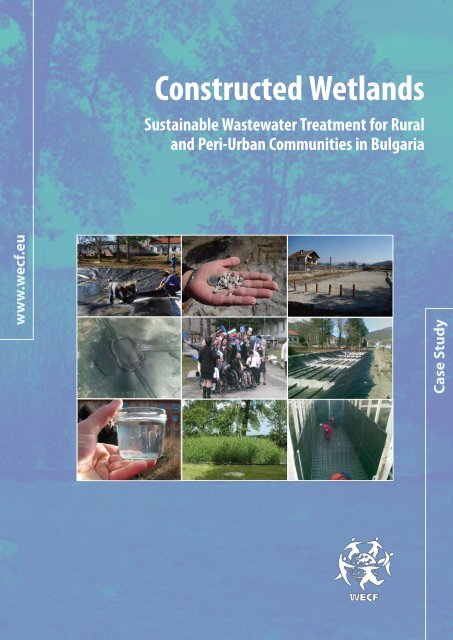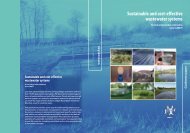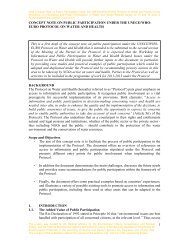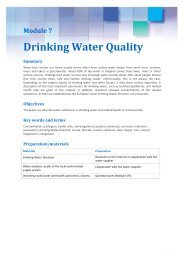Constructed Wetlands Sustainable Wastewater Treatment ... - WECF
Constructed Wetlands Sustainable Wastewater Treatment ... - WECF
Constructed Wetlands Sustainable Wastewater Treatment ... - WECF
Create successful ePaper yourself
Turn your PDF publications into a flip-book with our unique Google optimized e-Paper software.
www.wecf.eu<br />
<strong>Constructed</strong> <strong>Wetlands</strong><br />
<strong>Sustainable</strong> <strong>Wastewater</strong> <strong>Treatment</strong> for Rural<br />
and Peri-Urban Communities in Bulgaria<br />
Case Study
Publication Data<br />
© 2011 <strong>WECF</strong><br />
Authors<br />
Andrea Albold, Lübeck, Germany, albold@otterwasser.de<br />
Dipl.-Ing. Andrea Albold is executive director of the consultancy Otterwasser GmbH. She has worked more than 10 years in the field<br />
of wastewater treatment and as appointed member of the working group “<strong>Wastewater</strong> treatment in rural areas” (especially the<br />
working group “wastewater treatment with constructed wetlands ”) in the German Association for Water, <strong>Wastewater</strong> and Waste<br />
(DWA) she is specialized on decentralized and intelligent wastewater management systems.<br />
Dr. Claudia Wendland, Ahrensburg/München, Germany, claudia.wendland@wecf.eu<br />
Dr.-Ing. Claudia Wendland coordinates the sanitation implementation and policy work of <strong>WECF</strong>. Her professional experience covers<br />
more than 12 years in project management and implementation, lecturing and research in the field of wastewater treatment (Ruhr<br />
River Association, Lübeck University of Applied Science) and innovative sanitation concepts (Hamburg University of Technology,<br />
<strong>WECF</strong>). She is appointed member of the working group “New sanitation systems” in DWA.<br />
Bistra Mihaylova, EcoWorld2007, Sofia, Bulgaria, bistra_mih@yahoo.com<br />
Bistra Mihaylova is executive director of the environmental Bulgarian NGO EcoWorld 2007. During completion of her environmental<br />
studies at Munich University, her thesis focused on constructed wetlands for wastewater treatment. She has been coordinating<br />
several EU projects for <strong>WECF</strong>.<br />
Alp Ergünsel, Hamburg University of Technology, Germany, erguensel@tu-harburg.de<br />
Environmental Engineer Alp Ergünsel works at the Institute of <strong>Wastewater</strong> Management and Water Protection at Hamburg<br />
University of Technology as a research engineer. His professional experience covers research in the field of wastewater treatment<br />
and innovative sanitation concepts. Currently, he is involved in a project investigating the usage of algae in wastewater treatment.<br />
Hilda Galt, Utrecht, Netherlands, Hilda.galt@wecf.eu<br />
Hilda Galt specialises in sustainable development and energy efficient/low carbon technologies. She has professional experience<br />
working in the wastewater treatment sector, where it was her responsibility to develop and implement low-carbon and<br />
environmentally friendly alternatives to standard practice.<br />
Layout: Véronique Grassinger (Titel) und Claudia Wendland<br />
All figures and tables are developed by the authors, unless mentioned. Photos by the authors, unless mentioned.<br />
Project partner:<br />
This project is funded by the German Federal Environment Foundation (DBU).<br />
The content of this guidance paper does not reflect the opinion of the donor.<br />
The Netherlands / France / Germany<br />
Email: wecf@wecf.eu<br />
www.wecf.eu<br />
<strong>WECF</strong> – Women in Europe for a Common Future
<strong>Constructed</strong> <strong>Wetlands</strong><br />
<strong>Sustainable</strong> <strong>Wastewater</strong> <strong>Treatment</strong> for Rural and Peri-Urban<br />
Communities in Bulgaria<br />
Case study<br />
By<br />
Andrea Albold<br />
Claudia Wendland<br />
Bistra Mihaylova<br />
Alp Ergünsel<br />
Hilda Galt
Contents<br />
I Introduction ......................................................................................................................................... 3<br />
1. Scope of this Case Study .................................................................................................................. 3<br />
2. What is a Subsurface Flow <strong>Constructed</strong> Wetland?........................................................................... 3<br />
3. What Type of <strong>Wastewater</strong> can be Treated in a <strong>Constructed</strong> Wetland? ............................................ 5<br />
4. Does the Effluent of a <strong>Constructed</strong> Wetland Meet the Standards for Discharge or Re-use? ........... 6<br />
5. What are the Relevant Costs for <strong>Constructed</strong> <strong>Wetlands</strong>? ................................................................ 7<br />
II Design Considerations ....................................................................................................................... 7<br />
1. Pre-treatment Step ............................................................................................................................ 7<br />
2. Horizontal and Vertical Flow <strong>Constructed</strong> Wetland........................................................................... 8<br />
3. French System .................................................................................................................................. 9<br />
III Case Study Vidrare ........................................................................................................................... 11<br />
1. Background ..................................................................................................................................... 11<br />
2. The Vertical Flown <strong>Constructed</strong> Wetland in Vidrare ....................................................................... 12<br />
2.1. Design of the <strong>Wastewater</strong> <strong>Treatment</strong>...................................................................................... 12<br />
2.2. Construction of the wastewater treatment .............................................................................. 13<br />
2.3. Operation and Maintenance .................................................................................................... 14<br />
2.4. Costs ....................................................................................................................................... 16<br />
2.5. Other aspects .......................................................................................................................... 17<br />
3. Photo documentation during construction in Vidrare ...................................................................... 18<br />
IV References and Further Literature .................................................................................................. 21
I Introduction<br />
Sanitation, including wastewater collection and treatment systems, for small communities are a matter<br />
of concern in order to protect public health and the environment, especially the sources of drinking<br />
water. In many rural areas, a high number of treatment facilities are needed, but those that are<br />
installed are usually small in size. Due to differences in rural and urban settings, treatment facilities in<br />
rural areas must meet a number of criteria specific to these regions:<br />
Robust and reliable technology: Due to seasonal activities and a smaller structure size, rural<br />
wastewater treatment facilities are, compared to urban facilities, often subjected to high seasonal and<br />
even daily variations in wastewater flow and load, and thus require a resilient technology that ensures<br />
an adequate effluent.<br />
Easy to maintain and operate: Operation must be easily maintained with locally available staff and<br />
support. The technology should work sufficiently also in cases of interrupted electricity supply.<br />
Financially sustainable: Investment and operation costs must be affordable for the local community.<br />
Low energy and maintenance inputs keep the overall running costs low.<br />
Environmentally and climate sound: The technology should require little energy and be climate<br />
friendly. The treated effluent should be able to be re-used in agriculture.<br />
Both wastewater collection and treatment should be considered within a regional planning process to<br />
ensure long-term sustainability under various conditions. Treated wastewater, available in reliable<br />
quality and quantity, is a valued resource in rural/agricultural areas for irrigation or re-use as a fertiliser.<br />
1. Scope of this Case Study<br />
The scope of this case study is to provide information about the principles and guidance for the design<br />
of subsurface flow constructed wetlands as a sustainable wastewater treatment option, especially for<br />
small communities in Bulgaria, based on German national guidelines.<br />
After the first two chapters explaining the background and principles of constructed wetlands, the<br />
design and construction of the subsurface flow constructed wetland in Vidrare are described in chapter<br />
III. This is the first constructed wetland of this type in Bulgaria and treats the domestic wastewater of<br />
nearly 80 population equivalents (PE).<br />
This report targets decision-makers on ministerial and municipal level, authorities and utilities as well<br />
as consultants and NGOs with a technical background and working in the field of sanitation and<br />
wastewater management.<br />
It should be noted that this case study cannot serve as a general design manual. Any design will vary<br />
according to different boundary conditions such as composition and load of the inflowing wastewater,<br />
length and type of the sewerage etc. To design an adequate constructed wetland, an expert should be<br />
consulted from the field to properly adapt it to the local conditions.<br />
2. What is a Subsurface Flow <strong>Constructed</strong> Wetland?<br />
<strong>Constructed</strong> wetlands (CWs) are ‘‘engineered systems, designed and constructed to utilise the natural<br />
functions of wetland vegetation, soils and their microbial populations to treat contaminants in surface<br />
3
water, groundwater or waste streams” (ITRC 2003). <strong>Constructed</strong> and planted filter beds provide the<br />
space for biological treatment of effluent. The main performance is the bio-chemical treatment in the<br />
biofilm of the filter bed. Filter beds usually contain one of two different types of filtering material, usually<br />
sand or gravel.<br />
<strong>Constructed</strong> wetlands were first used in Germany over 40 years ago for the treatment of domestic<br />
wastewater treatment mostly in rural areas. In addition, constructed wetlands have now been adapted<br />
to also treat wastewaters from agriculture, industry and landfills.<br />
<strong>Constructed</strong> wetlands are usually defined according to their flow regime in the filter bed. There exist<br />
both free water and subsurface flow constructed wetlands; and the flow through the filter bed can be<br />
either vertical or horizontal. Today, subsurface flow CWs are the predominant wetland type in Europe.<br />
A constructed wetland comprises a pre-treatment step (settling tanks) for the sedimentation of solid<br />
organic matter in order to reduce the load and avoid clogging of the filter bed. A type of constructed<br />
wetlands without this pre-treatment has been successfully developed in France (therefore often called<br />
the French system).<br />
This case study only deals with subsurface flow CW and with coarse sand as filter bed material.<br />
3.<br />
<strong>Constructed</strong> wetland for greywater treatment in Vorarlberg, Austria<br />
<strong>Constructed</strong> wetland for municipal wastewater in Örlinghausen, Germany<br />
4
3. What Type of <strong>Wastewater</strong> can be Treated in a <strong>Constructed</strong><br />
Wetland?<br />
<strong>Constructed</strong> wetlands are able to treat different urban and rural wastewater flows. The quality and<br />
quantity arising from the different sources can significantly vary.<br />
Urban wastewater, according to the EC Urban Waste Water <strong>Treatment</strong> Directive (UWWTD), is defined<br />
as a mixture of domestic and industrial wastewater, see the following table. Rainwater (run-off<br />
rainwater) is considered within the urban wastewater flow in case of combined sewerage.<br />
In rural areas the total quantity of wastewater treated is usually greater than that which would be<br />
produced from an equivalent urban population. This is due to rural networks, which are usually longer<br />
than urban networks, being susceptible to additional sewer infiltration water thorough, for example<br />
ground water infiltration by leakages and illegal connections. This significantly increases the total<br />
quantity wastewater to be treated, and should be taken into account when planning a treatment facility.<br />
Toilet wastewater<br />
(Urine, brownwater<br />
(faeces + flush water)<br />
10,000 – 25,000<br />
liter/person/year<br />
depending on the type<br />
of toilet<br />
Definition of urban wastewater<br />
Domestic wastewater<br />
Greywater (Water from<br />
personal hygiene,<br />
kitchen and laundry,<br />
not from the toilets)<br />
25,000 – 100,000<br />
liter/person/year<br />
depending on the<br />
status of water saving<br />
devices in the<br />
households<br />
Urban wastewater<br />
Industrial<br />
wastewater<br />
Quantity depends<br />
on the industrial<br />
activities in the<br />
agglomerations<br />
and their<br />
wastewater<br />
management<br />
Sewer<br />
infiltration<br />
water<br />
Quantity can<br />
be high<br />
depending<br />
on the<br />
sewerage<br />
condition<br />
<strong>Constructed</strong> wetlands can be used for the following wastewater streams (GIZ 2011):<br />
• Domestic wastewater<br />
• Greywater<br />
• Urban wastewater from combined or separated sewerage<br />
• Industrial wastewater treatment such as effluent from paper mills etc.<br />
• Sludge dewatering and mineralization of faecal sludge or sewage sludge<br />
Run-off<br />
rainwater<br />
Is included in<br />
the urban<br />
wastewater in<br />
case of<br />
combined<br />
sewerage<br />
Quantity<br />
depends on<br />
the climate and<br />
the sewerage<br />
type<br />
This case study outlines an example of domestic wastewater treatment in Vidrare. In case of other<br />
wastewater streams, the design must be adapted according to the different hydraulic and organic<br />
loads.<br />
5
4. Does the Effluent of a <strong>Constructed</strong> Wetland Meet the Standards<br />
for Discharge or Re-use?<br />
Subsurface flow CWs can treat wastewater to a standard suitable for discharge to surface water or for<br />
various re-use applications. In any case, the constructed wetland needs to be approved by the local<br />
authorities.<br />
There are no specific EU regulations for such on-site treatment systems. According to the Urban<br />
<strong>Wastewater</strong> <strong>Treatment</strong> Directive (UWWTD 1991), agglomerations with more than 2,000 population<br />
equivalents (PE) must set up appropriate treatment (removal of 70-90% BOD, COD and SS 1 ), and also<br />
the agglomerations with less than 2,000 PE which already have a sewerage network (Article 7 of the<br />
UWWTD). For agglomerations with less than 2,000 PE lacking any central sewerage network, there<br />
are no standards to meet.<br />
On the other hand, the Water Framework Directive (WFD 2000) regulates the quality of the receiving<br />
waters, surface or ground waters. In cases where the effluent is to be discharged into environmentally<br />
sensitive areas, the local authorities can require advanced standards. If the treated wastewater is<br />
intended for re-use there are guidelines set by the WHO (WHO 2006). The design of the subsurface<br />
flow CW should be in line with the desired effluent quality for disposal or re-use.<br />
The most common type of re-use is irrigation in agriculture, such as drip irrigation or subsurface<br />
irrigation for lawns, green spaces or crop production. In this case, utilisation of nutrients contained in<br />
the wastewater rather than nutrient removal is desirable. Relevant guidelines must be followed to<br />
ensure this practice is hygienically safe for crop consumers and workers in contact with treated<br />
wastewater. International standards for re-use and guidelines can be found in WHO (2006).<br />
<strong>Constructed</strong> wetlands can significantly remove pathogenic indicators by 1 – 3 log orders, similar to<br />
technical activated sludge systems. Greywater which has been treated in subsurface flow CWs usually<br />
meets the standards for pathogen indicators for safe discharge to surface water without further<br />
treatment. In the case of domestic and urban wastewater, further treatment e.g. in a pond or UV<br />
treatment might be necessary, depending on the intended re-use application and standard.<br />
Treated effluent of a constructed wetland<br />
1 Biochemical oxygen demand [BOD5 at 20°C] 25 mg/l O2 (70-90 % percentage of reduction)<br />
Chemical oxygen demand [COD] 125 mg/l O2 (75 % percentage of reduction)<br />
Total suspended solids [SS] 35 mg/l (90 % percentage of reduction)<br />
6
5. What are the Relevant Costs for <strong>Constructed</strong> <strong>Wetlands</strong>?<br />
The investment costs of constructed wetlands are dependent on the price of the land on which the<br />
treatment plant is to be constructed; as it needs more space than a technical plant, but less space than<br />
a pond. The costs also depend on the price of the coarse sand needed to fill the filter bed (GIZ 2011),<br />
and the staff costs for the construction.<br />
Financial decisions should not only take the initial investment into account but also the running costs<br />
for operation and maintenance in the long-term. <strong>Constructed</strong> wetlands require much lower running<br />
costs as no technical aeration is needed and less operators´ time. The only devices that requires<br />
electricity are the pumps. If there is a natural slope that can be used instead of pumps, the constructed<br />
wetland can be operated without electricity demand.<br />
II Design Considerations<br />
1. Pre-treatment Step<br />
A successful physical pre-treatment step is necessary to ensure a good performance from this type of<br />
constructed wetland. Unsatisfactory pre-treatment may lead to a build-up of solids in the inflow area,<br />
odour nuisances, clogging of the filter or blockages of the distribution pipes. The pre-treatment can be<br />
realized as primary sedimentation in settling tanks. For small scale plants, septic tanks are typically<br />
used. Primary sludge from these tanks should be removed regularly (e.g. once or twice a year).<br />
Design criteria for settling tanks: 2 or 3 chamber settling tanks, the pre-treatment includes the settling<br />
zone (hydraulic residence time: 4 hours) and the storage volume of the sludge until the emptying<br />
(0.9 l/d*PE)<br />
One alternative pre-treatment step to the settling tanks is the Imhoff tank which simultaneously treats<br />
and reduces the primary sludge (Imhoff 2006). Secondly, a pond can be an option for pre-treatment<br />
but it tends to smell and requires much more space than settling tanks or an Imhoff tank.<br />
Only the French system, discussed in Chapter III, does not require any pre-treatment step due to<br />
different design of the filter layers and flow regime in the filter beds.<br />
View into the settling tank for pre-treatment of greywater<br />
7
2. Horizontal and Vertical Flow <strong>Constructed</strong> Wetland<br />
General design of the constructed wetland<br />
Following pre-treatment, the effluent is passed through a soil filter, which can be either vertical or<br />
horizontal. The influent should be fed intermittently to provide aerobic conditions in the filter.<br />
Horizontal flow constructed wetland with pre-treatment (www.bodenfilter.de)<br />
Vertical flow constructed wetland with pre-treatment (www.bodenfilter.de)<br />
Horizontal flown soil filter: design criteria for the filter area is 5 m 2 per PE for domestic wastewater,<br />
hydraulic surface load max. 40 mm/day and mass surface load 16 g O2/m²*d Chemical Oxygen<br />
Demand (COD). The depth of the filter is 0.5 – 1.0 m. The filter contains coarse sand (mixture of sand<br />
and gravel).<br />
Vertical flown soil filter: design criteria are 3.5 - 4 m 2 per PE for domestic waste water, 80 mm/day<br />
hydraulic surface load and mass surface load 20 g O2/m²*d COD. The depth of the filter is 0.5 – 1.0 m.<br />
The filter contains coarse sand (mixture of sand and gravel). At the bottom a drainage layer with<br />
drainage pipes made of plastic is implemented.<br />
In both cases, the design criteria may vary depending on the average yearly temperatures.<br />
8
Performance of horizontal and vertical flown constructed wetlands:<br />
The results in terms of organic matter achieve more than 80% COD removal and thus achieves<br />
common standards for discharge. Pathogenic indicators are removed by 1 – 3 log orders.<br />
If the effluent is discharged into eutrophic or sensitive receiving water such as bathing water, nutrient<br />
removal might be required. Due to aerobic conditions in subsurface flow systems, a partial nitrification<br />
takes place, but denitrification is limited. To ensure N-removal, a two-stage-constructed wetland (first<br />
vertical/second horizontal flow) is needed to meet the requirements for discharge.<br />
If high standards for phosphorus removal and hygienic parameters are required, additional steps (e.g.<br />
chemical precipitation for P removal, disinfection) should be applied.<br />
Reference for the design of constructed wetlands<br />
DWA (2006). A 262. Principles for the Dimensioning, Construction and Operation of Planted Soilfiters<br />
for Urban <strong>Wastewater</strong> <strong>Treatment</strong>. German Association for Water, <strong>Wastewater</strong> and Waste (DWA)<br />
3. French System<br />
<strong>Constructed</strong> wetland for domestic wastewater treatment in Poland<br />
Whilst the two systems outlined above are fully functional, an alternative system was developed in<br />
France which requires no pre-treatment. The French system feeds the soil filter vertically with raw<br />
wastewater. The flow of the influent must be greater than the infiltration speed in order to correctly<br />
distribute the sewage over the whole bed surface (intermittently).<br />
9
The French system is usually applied for urban wastewater from combined sewers where the<br />
wastewater quality is more diluted due to run-off water. It always needs two stages and parallel beds in<br />
each stage, see scheme below.<br />
Top view scheme of a serie of vertical flow constructed wetlands (French system) (EC 2001)<br />
First stage<br />
The design of the French system comprises two stages each with parallel soil filters as seen in the<br />
figure. The first one has three parallel soil filters. If one is active, the others are in a resting phase. The<br />
design criteria for the filter area is 1.2 - 1.5 m 2 per PE for this first stage. The media in the filter<br />
contains gravel in the upper layer to avoid clogging. The total depth is around 80 cm.<br />
Second stage<br />
The second stage is provided with two parallel soil filters which are used alternating and fed<br />
intermittently like the first stage. The design criteria for the filter area is 0.8 m 2 per PE. The media in<br />
the filter is sand and the total depth is 80 cm.<br />
Performance of the French system:<br />
The results in terms of organic matter achieve more than 80% COD removal which is similar to the<br />
other systems. Pathogenic indicators are also removed by 2 – 3 log orders.<br />
This two step constructed wetland can provide an efficient nitrogen removal if adequately designed<br />
and can achieve requirements for discharge into sensitive areas.<br />
The reduction in phosphorus depends on the adsorption capacity of the media and the age of the plant<br />
but is usually limited.<br />
Reference for the design of constructed wetlands (French system)<br />
Agence de l´Eau Seine Normandie (1999) Guides des procédés épuratoires intensifs proposés aux<br />
petites collectivités, Nanterre<br />
10
III Case Study Vidrare<br />
1. Background<br />
The Home of Handicapped People in Vidrare, part of the municipality in Pravets, Bulgaria, wanted to<br />
build a treatment plant for the domestic wastewater produced by the centre (from the kitchen, toilets<br />
and laundry) in order to improve the existing situation.<br />
Home of Handicapped People in Vidrare<br />
Effluent of the old septic tanks in a gully<br />
Together with the municipality of Pravets, the non-governmental organisations <strong>WECF</strong> and<br />
EcoWorld2007 of Bulgaria started the activities in 2008. A water meter was installed in the Home in<br />
order to estimate the quantity of wastewater produced. The stakeholders in Vidrare and Pravets were<br />
informed about constructed wetlands as a suitable low-tech option for improved wastewater treatment.<br />
After a meeting on-site, the decision was made to build a constructed wetland for wastewater<br />
treatment in the yard of the Home; designed to be attractive in appearance. The municipality agreed to<br />
permit the installation of the first constructed wetland in Bulgaria, hoping that it would also serve as a<br />
demonstration plant that could be replicated by other municipalities.<br />
The German Federal Environment Foundation (DBU) approved the proposal submitted by <strong>WECF</strong> and<br />
EcoWorld2007 and ensured the main funding. The planning and design was carried out by<br />
Otterwasser (Lübeck/Germany) and Ecoproject (Bulgaria). The tender was won by the Bulgarian<br />
Interstroy group, and construction began in October 2010 to be finished in April 2011 (a break of three<br />
months was required due to harsh winter conditions). The site will also be surrounded by a fence.<br />
The director of the Home agreed that there should be an appointed staff member responsible for the<br />
maintenance of the constructed wetland. This staff member will be instructed by Otterwasser.<br />
11
2. The Vertical Flown <strong>Constructed</strong> Wetland in Vidrare<br />
2.1. Design of the <strong>Wastewater</strong> <strong>Treatment</strong><br />
The wastewater treatment plant consists of a settling tank for the pre-treatment and the planted<br />
soilfilter for the biological step.<br />
At the moment 88 children and adults are living in the Home for Handicapped People. 25 of the<br />
inhabitants are using diapers. 65 persons are working in shifts. Apparently 25 persons are working in<br />
one shift together. The whole home has a capacity of 95 beds.<br />
Pre-<strong>Treatment</strong><br />
In order to calculate the dimensions of the pre-treatment step the maximum number of beds (95) was<br />
multiplied by the water supply per bed (115 l/bed*d, according to the Bulgarian Regulation N4) (see<br />
below).<br />
12<br />
Settling volume:<br />
Conventional treatment settling times for primary clarifiers require a retention time of 2 hours. For<br />
constructed wetlands, however, it is recommended that this be extended to up to 4 hours to avoid<br />
solids clogging the top layer of the filter bed.<br />
The maximum inflow is calculated as follows:<br />
<strong>Wastewater</strong> volume: 115 l/(bed*d) resulting in 115 l/(bed*d) * 95 beds = 11 m³/d<br />
The wastewater accumulated in 8 hours, so the maximum wastewater volume per hour was:<br />
11 m³/d: 8 h/d = 1.4 m³/h<br />
Calculation of required settling volume: 1.4 m³/h * 4 h = 5.5 m³<br />
Sludge storage volume:<br />
In addition to the settling of the incoming solids, a volume for storage of the sludge over a defined<br />
period has to be calculated.<br />
Volume of sludge: 0.9 l/p*d (Imhoff 2006)<br />
The yearly volume of sludge stored was also calculated: VS = 0.9 l/p*d * 365 d/yr * 76 p = 25 m³<br />
The required volume for the settling tank was calculated from the volume of solids in the settling and<br />
the sludge stored: VS = 5.5 m³ + 25 m³ = 30.5 m³<br />
It is recommended that the settling tank will be emptied every 6 months, so the calculated tank volume<br />
was reduced as follows: Vs = 25 m³/2 + 5.5 m³ = 18 m³<br />
Biological step: planted soilfilter<br />
In order to calculate the dimensions of the constructed wetland the figures for the wastewater load<br />
were used. It was assumed that 28 % (27 children) of the Home’s younger inhabitants (totalling 95<br />
children) were using diapers. For the load of the employees, it was calculated 8 PE. The resulting PE
was 95-27+8 = 76 PE. The German standard (DWA A 262 2006) recommends that 3,5 m³/PE of space be<br />
used for the building of the constructed wetlands.<br />
The area required was calculated as follows:<br />
A = 3.5 m²/p * 76 p = 266 m²<br />
The area required was divided into two filter beds of 133 m² each.<br />
Residual materials:<br />
Settling tank: The sludge from the settling tank has to be taken out once or twice a year. It needs to be<br />
treated/stabilised and might be used as soil conditioner and fertiliser in agriculture if the quality is<br />
according to the standards. Otherwise the sludge must be disposed via a conventional wastewater<br />
treatment plant.<br />
Planted soil filter: After the growing phase of two seasons, the plants have to be cut and removed once<br />
a year.<br />
Generally the soil filter bed has to be exchanged, at least partly, as soon as there is a clogging of the<br />
filter bed. Experiences with constructed wetlands show that filter beds usually stay more than 20 years<br />
without the need to replace it.<br />
2.2. Construction of the wastewater treatment<br />
The wastewater from the toilets, the showers, the kitchen and the laundry flows by gravity into the<br />
settling tank for pre-treatment. The settling tank comprises two equal-sized chambers where the solids<br />
are separated. In this case study, the pre-treatment tank was constructed with reinforced concrete,<br />
pictured below.<br />
Pre-treatment step: 2 chamber settling tank. 3 rd chamber pumping shaft<br />
The overflow runs into the pumping shaft, pictured as a small compartment at the far end in the picture<br />
above. Two to three daily, nearly 3 m³ of pre-treated wastewater is pumped onto the surface of the<br />
planted soil filter (biological step) via the distribution pipes.<br />
13
From the bottom to the top, the soil filter comprises the following layers:<br />
14<br />
1. Levelling layer - depth around 10 cm<br />
2. Geo-textile layer – provides protection against roots and burrowing animals (e.g. moles or rats)<br />
3. Impermeable liner (HDPE 1.5 mm) - prevents the uncontrolled flow of water in or out of the<br />
filter<br />
4. Conventional drainage pipes with a diameter of DN 100 or DN 150 - for the controlled outflow<br />
of the treated water. Composed of gravel (2/8 grain size), with a depth of more than 20 cm. A<br />
small sampling shaft should also be built.<br />
5. Biological treatment layer – composed of sand (0/4 grain size), with a depth of more than<br />
50 cm.<br />
6. Cover layer – composed of gravel (8/16 grain size). Contains distribution pipes and is planted<br />
with reed. The layer has to protect the pipes and help to distribute the wastewater over the<br />
whole area.<br />
Drainage layer with pipes<br />
After passing the outlet shaft following the biological step, the treated wastewater is discharged into a<br />
gully that enters the nearby river.<br />
2.3. Operation and Maintenance<br />
Although the technology of the constructed wetland is relatively simple, a number of operational and<br />
maintenance tasks are needed to ensure the proper performance of the plant. The following table<br />
shows the activities that are needed during the year to maintain the system. It is necessary that one<br />
appointed person is responsible for the maintenance and activity plan.
General tasks<br />
General function control of the technical parts<br />
(warning device, control lamps)<br />
Operation diary x<br />
Record water consumption<br />
<strong>Treatment</strong> plant<br />
x<br />
daily weekly yearly<br />
Pipes and manholes 1x<br />
Emptying the settling tank (pumping out the sludge) 2x<br />
Visual inspection of the surface of the constructed<br />
wetland (plants, weeds, dry zones, water on the<br />
surface et al.)<br />
x<br />
Function control of the pumps 12x<br />
Visual control of the discharge x<br />
Maintenance<br />
Pumps 1x<br />
Analysing a sample of the effluent (frequency<br />
depends on the regulations of the water authority)<br />
The yearly maintenance of the wastewater treatment plant includes:<br />
x<br />
1x<br />
Activity plan for self monitoring of the constructed wetland<br />
• Checking the settling tank damages to the concrete.<br />
• Keeping a record of sludge output (date and volume on the operation diary)<br />
• Controlling the intervals of feeds. The volume per pass of the pump of the constructed wetland has<br />
to be controlled.<br />
• Controlling floating switches and pumps, and if necessary cleaning the switches.<br />
• Ensuring clogging does not occur in the biological stage (visual inspection for wet zones, sludge<br />
appearance on the surface, trenches on the surface etc).<br />
• Maintaining plant growth (e.g. harvesting the reed)<br />
• General pump maintenance, including cleaning and changing the oil.<br />
• Controlling the duration of the pass of the pump, and if necessary correcting the runtime.<br />
• Checking for concrete damages and sludge sedimentation in the control shaft.<br />
• Sampling of the discharged water according to the regulations of the water authority.<br />
• Up-keep of records in the operation diary.<br />
15
2.4. Costs<br />
Investment costs<br />
The figures listed here detail the costs incurred during construction of the constructed wetland (with a<br />
filter bed of 266 m²) in Vidrare; including pre-treatment, with required shafts, installation of pipes from<br />
the Home and to the gully.<br />
Figure showing the distribution of the investment costs in Vidrare<br />
Investment costs<br />
Excavation and piping 12.000 €<br />
Pre-treatment step (concrete) 6.000 €<br />
Soil filter<br />
Liner (Geotextile and PE foil): 6.000 €<br />
16<br />
Gravel, Sand 7.000 €<br />
Distribution pipes, drainage pipes and fittings 9.500 €<br />
Pumps including controller and cabel 4.500 €<br />
Total investment costs 45.000 €<br />
Plus planning and design / planning application (getting<br />
the approval)<br />
Distribution of the investment costs in Vidrare including planning and design<br />
+ 10% of the investment<br />
costs
Operation and maintenance costs<br />
The operation and maintenance costs are highly dependent on the local cost of energy and staff. The<br />
required time and energy supply are listed here:<br />
• Time needed for operation and maintenance: 1.5 h / week (80 h /yr)<br />
• Energy supply for the pumps: 2 kWh/d (750 kWh/yr)<br />
• Sludge disposal from the pre-treatment step: 36 m³/yr<br />
2.5. Other aspects<br />
Timing<br />
Timing is often very difficult as it depends on many factors, detailed below:<br />
Stage Activity Duration<br />
1. Design of the wastewater treatment installations incl. drawings and details:<br />
Approval by the municipality and the water authorities - if the decision<br />
2 months<br />
2. makers are not familiar with the system time is needed to explain the<br />
technical aspects<br />
3 - 6 months<br />
3. Tender including all documents and selection of the company 4 weeks<br />
4. Construction (incl. terms of delivery etc.) - highly depending on the weather 4 - 6 months<br />
5. Planting the reed and start-up operation 2 - 3 months<br />
Timetable for the implementation of a constructed wetland<br />
The most time consuming activity was obtaining the necessary permits for construction and operation<br />
of the constructed wetland. Familiarising the Bulgarian authorities with this new technology also proved<br />
time-consuming.<br />
Developers should also be aware that unforeseen problems are likely to arise during construction.<br />
This project, for example, experienced difficulties in construction due to the presence many<br />
underground cables and pipes in the yard of the Home, which had not been mentioned in previous<br />
documentation. The construction company first had to determine the location of these pipes and wires,<br />
and then modify their plans to avoid damaging them. This was a time-consuming challenge.<br />
Construction and Materials<br />
It is often useful to use materials that are available in the region, such as the coarse sand and gravel.<br />
In some regions, pre-fabricated shafts made of reinforced concrete for the pre-treatment step are<br />
available. A cost comparison is recommended to check if the pre-fabricated parts are cheaper than<br />
constructing the shaft with reinforced concrete on-site. Plastic tanks can also be used. In the case of<br />
Vidrare, the construction on-site with reinforced concrete was the cheapest option.<br />
During construction, it was necessary to visit the site regularly, ideally daily, to check on the progress<br />
and quality of the construction. Crucial installations, e.g. the welding of the liner at the outlet of the<br />
filter, need to be inspected.<br />
17
3. Photo documentation during construction in Vidrare<br />
Construction of the pre-treatment step (settling tanks):<br />
Digging for the settling tank<br />
Reinforcement of concrete (settling tanks)<br />
18<br />
Digging for the settling tank with levelling layer<br />
Settling tanks completed
Planted soil filter:<br />
Welding the liner<br />
Welding the liner<br />
Liner (HDPE 1.5 mm)<br />
Drainage pipes<br />
Welding the liner<br />
Sand (in front) and gravel<br />
19
Gravel for drainage layer<br />
Completed constructed wetland, without plants<br />
Completed constructed wetland with vent pipes in front<br />
20<br />
Gravel for cover layer
IV References and Further Literature<br />
Agence de l´Eau<br />
Seine Normandie<br />
1999<br />
DWA A 262 2006<br />
European<br />
Commission 2001<br />
GIZ 2011<br />
Guide des procédés épuratoires intensifs proposés aux petites collectivités, Nanterre<br />
Principles for the Dimensioning, Construction and Operation of Planted Soilfiters for Urban<br />
<strong>Wastewater</strong>. German Association for Water, <strong>Wastewater</strong> and Waste<br />
Extensive <strong>Wastewater</strong> <strong>Treatment</strong> Processes adapted to small and medium sized<br />
communities (500 – 5,000 PE)” http://ec.europa.eu/environment/water/waterurbanwaste/info/pdf/waterguide_en.pdf<br />
Technology review of constructed wetlands, Subsurface flow constructed wetlands for<br />
greywater and domestic wastewater treatment, http://www.gtz.de/en/dokumente/giz2011-entechnology-review-constructed-wetlands.pdf<br />
Imhoff, K.R. 2006 Taschenbuch der Stadtentwässerung (in German)<br />
Technical and Regulatory Guidance Document for <strong>Constructed</strong> <strong>Wetlands</strong>, the Interstate<br />
ITRC 2003<br />
Technology Regulatory Council <strong>Wetlands</strong> Team, USA,<br />
http://www.itrcweb.org/Documents/WTLND-1.pdf<br />
Ministry of regional<br />
development,<br />
Bulgaria 2005<br />
UWWTD 1991<br />
<strong>WECF</strong> 2010<br />
WHO 2006<br />
Regulation N4 from 17th of June 2005 for design, construction and operation of water<br />
supplies and sewage systems in buildings.- Prepared by the ministry of regional<br />
development.<br />
Council directive of 21 may 1991 concerning urban waste water treatment (91/271 EEC),<br />
http://eur-lex.europa.eu/LexUriServ/LexUriServ.do?uri=CELEX:31991L0271:EN:HTML<br />
<strong>Sustainable</strong> and Cost-Effective <strong>Wastewater</strong> Systems for Rural and Peri-Urban Communities<br />
up to 10,000 PE, http://www.wecf.eu/download/2010/03/guidancepaperengl.pdf<br />
Guidelines on the Safe Use of <strong>Wastewater</strong>, Excreta and Greywater. Volume 4: Excreta and<br />
Greywater Use in Agriculture, WHO/UNEP,<br />
http://www.who.int/water_sanitation_health/wastewater/gsuweg4/en/index.html<br />
21
<strong>Constructed</strong> <strong>Wetlands</strong><br />
<strong>Sustainable</strong> <strong>Wastewater</strong> <strong>Treatment</strong> for Rural<br />
and Peri-Urban Communities in Bulgaria<br />
<strong>Constructed</strong> wetlands are sustainable and cost-effective wastewater<br />
treatment systems that have a number of advantages compared to<br />
conventional technical systems: they maintain a high performance, use<br />
less energy, sequester carbon, require less operation and maintenance<br />
and are better able to cope with the impacts of climate change.<br />
In this publication, the first constructed wetland demonstration plant<br />
for 80 population equivalents in Bulgaria is discussed. The design,<br />
construction and operation of this subsurface flow constructed wetland<br />
are detailed as implemented in Vidrare, Pravets municipality.

















